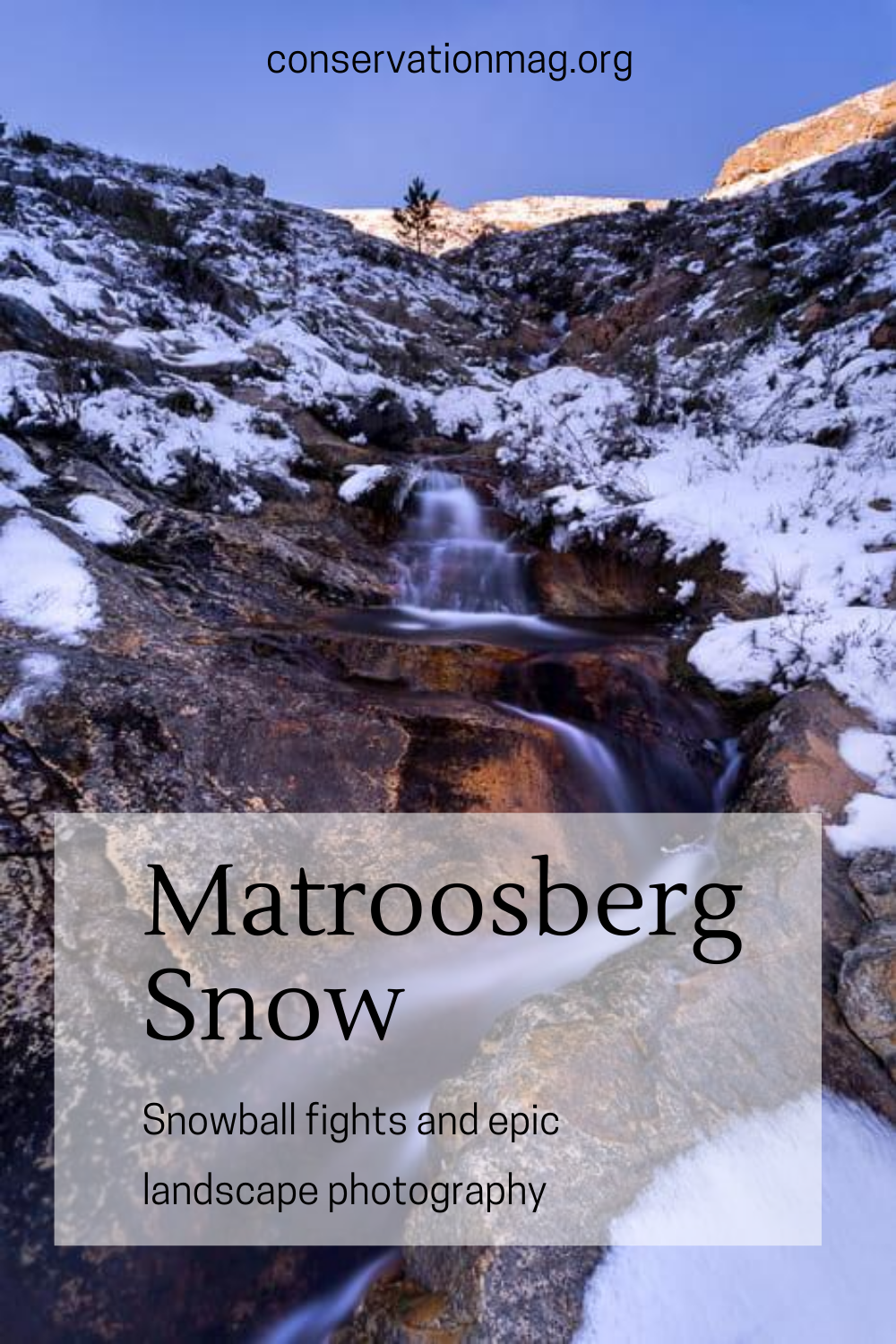Matroosberg Private Nature Reserve is located just 30 kilometres outside of Ceres and only 2 hours’ drive outside of Cape Town. When snow falls, you need to be quick to get there; there is no guarantee it’ll be around for long. I have created a comprehensive guide to help you navigate the experience.
For many South Africans getting the chance to play in the snow is quite a luxury. Barring a few locations at high altitudes, snow is a rarity that happens only once every few years.
Which is why when it does fall, we go nuts embracing our inner child in spontaneous snowball fights or even building snowmen on car bonnets, a peculiarly South African quirk I’ve seen on more than one occasion.
Thankfully, this year has already seen a good sprinkling with snowfalls in the Ceres valley in the Western Cape all the way into the Karoo, in the Northern Cape, and into the higher parts of the Drakensberg which border Lesotho.
Where can I see snow in South Africa?
When it is snow season some of your best chances to catch a glimpse in the Western Cape are to check out Mont Rochelle, in Franshoek, the Hex River Valley and even the Cederberg and Ceres mountains. I’ve been lucky enough to shoot snow on three occasions in these areas this year already, and they’ve all been thoroughly interesting experiences.
There are quite a few iconic ‘snowscapes’ that I would love to visit.
Should you be planning on making a trip out of it I recommend looking out for snow in the Drakensburg’s Amphitheatre, KwaZulu Natal, the Sani Pass, in the Eastern Cape and of course Sutherland, in the Northern Cape.
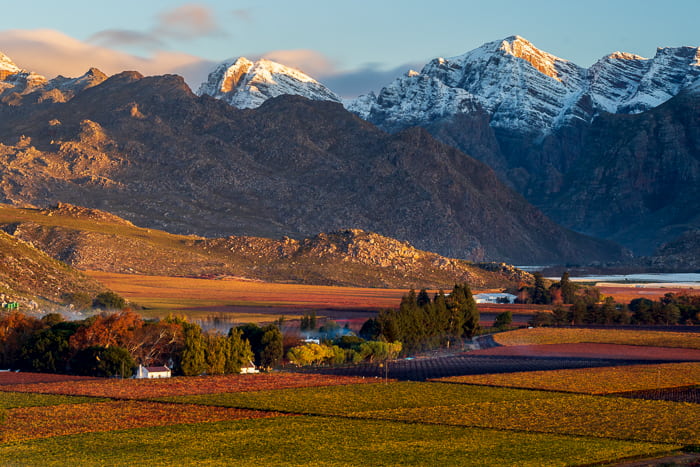
Snow-capped mountains in the Hex River Valley, the opposite side of the Matroosberg Reserve. Shot at 75mm 20 seconds at f/14 ISO 100
When snow does fall you need to be quick to get to it. There is no guarantee it’ll be around for long and it’s completely possible for it to melt within a day – especially under our South African sun when temperatures can hit 23 degrees Celsius the day after a storm.
To make the most out of it I keep a close eye on local weather forecasts and Snow Reports in case another cold front rolls in. I’ve found setting Twitter and Facebook alerts to accounts like Snow Report SA as well as the South African Weather Service are great ways of getting the information to come to you, rather than having to spend hours on the internet refreshing weather reports to get it.
Some of these channels even have live webcams in some of the most iconic locations in SA, so you can see how much snow has fallen for yourself before leaving the comfort of your couch.
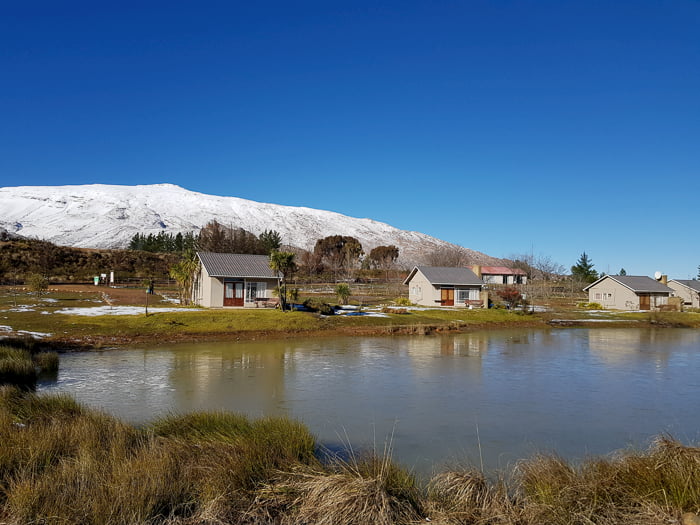
Matroosberg Private Nature Reserve’s Lakeside Chalets. This small dam froze overnight. Photo Jay Caboz
Let’s go to the Matroosberg Private Nature Reserve on a snow adventure
By far the best experience I have had this year has been from a recent overnight trip to Matroosberg Private Nature Reserve, located just 30 kilometres outside of Ceres and just 2 hours’ drive outside of Cape Town.
The reserve is situated on the working farm Erfdeel and offers a host of adventure activities from 4 x 4 trails and hiking to skiing, fishing and cherry picking.
During the winter months, the reserve is often covered with snow and its southern slopes have been known to remain snow-clad for quite some time – which makes it a great starting point for anyone looking to get a variety of snow shots.
For day visitors entrance fees are R65 per person with kids under 13 paying a discounted price.

3D map of the Matroosberg Nature Reserve, the reserve is 2 hours’ drive from Cape Town. Source Google maps
For those looking to stay overnight they offer camping as well as a variety of self-catering cottages.
But, be warned. It’s best to come fully stocked for a campout regardless of where you stay – because there is no guarantee you’ll have running water or electricity. This is exactly what happened to us when we stayed in one of their Lakeside chalets overnight on a business travel permit for R1,650.
With no electricity and nothing but an indoor fireplace, the temperature quickly plummeted to a chilly -3 degrees Celsius. If we had not brought along warm clothing it would have been quite a miserable night.
It also got so cold that the water pipes froze overnight. Luckily, we had a gas burner and simple walked out our front door, scooped up some snow for a quick coffee to get the day going.
What can you shoot?
Regardless, of our challenges the experience was worth the cold sleep. The Matroosberg Reserve has a variety of photo opportunities from snowy peaks within the valley and to dams and hiking trails surround it. I would aim to get into the reserve at least 2 hours before sunset to pick your spot, because there is a lot to choose from.

Panoramic stich of the Matroosberg valley at sunset. Photo Jay Caboz
Snow can radically transform landscapes. A thick blanket can completely cover anything in the foreground eliminating familiar subject matter and leaving the image looking white, flat, and lifeless.
I try to bring to life subject matter using contrast and simple minimal compositions. Look for pops of colour that stand out - like people wearing colourful jackets.
Don’t be afraid to get down low to the ground and capture reflections in puddles to add that little bit extra to your shot.
While we were quite lucky to get clear blue skies, often there’ll be moody clouds about, so when you see a shot take it, because chances are if you go back the light won’t be the same.
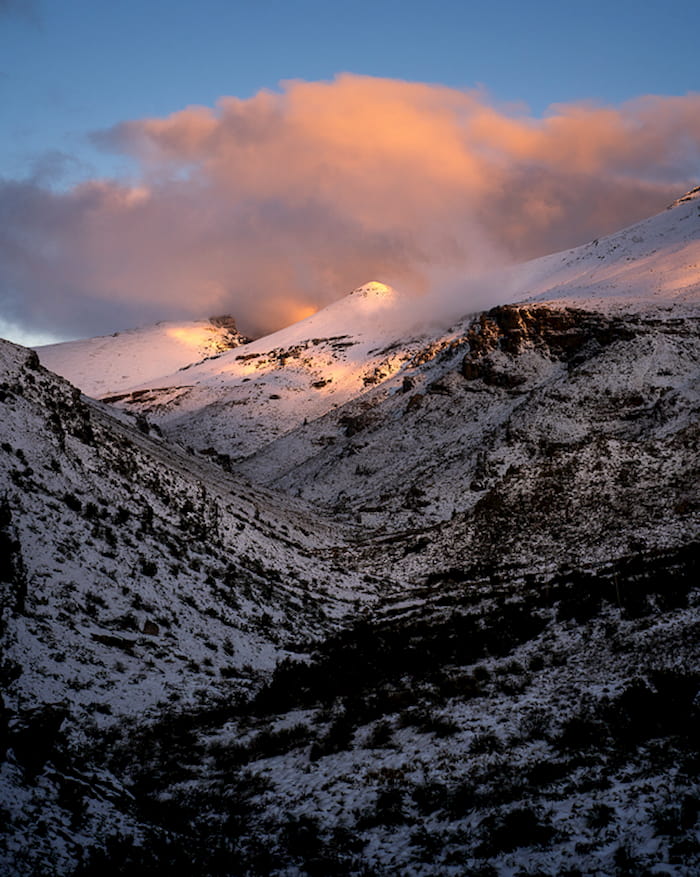
Peach sunset in the Matroosberg Private Nature Reserve. Shot at 75mm at 1/125th second at f10 ISO 100. Photo Jay Caboz
For sunset, we chose to shoot at the foot of the 4 x 4 trail with some excellent light falling on the Matroosberg mountain. It was truly a breath-taking scene to witness as the last bits of pink light fell off the snow with some clouds moving around the peak.
The next morning, way before sunrise, we headed out in the hopes of getting up the 4 x 4 track early to get as close to the snow as we could. You can purchase a 4 x 4 permit for an R250 fee or an R200 fee for their 4 × 2 trail.
But, because of the cold weather the track was closed. The 4 x 4 trail will only open once it is safe enough to drive on so there is a guarantee you’ll be able to get up the slope at all.
Nevertheless, we chose to continue to explore the inside of the valley where I found this unexpected waterfall.

Waterfall in the Matroosberg valley. Shot at 17mm at 25 seconds at f11 ISO 50. Photo Jay Caboz
In hindsight choosing to move into the valley was not a great move as the valley was in deep shade for most of the morning.
So we decided to head back out the valley and found this stunning dam which had frozen overnight. The contrast between the clear blue sky and the orange bedrock really stood out for me. I used a polarizing filter to reduce the glare in the lake to emphasise the bedrock, trapped air pockets and sticks frozen in the ice
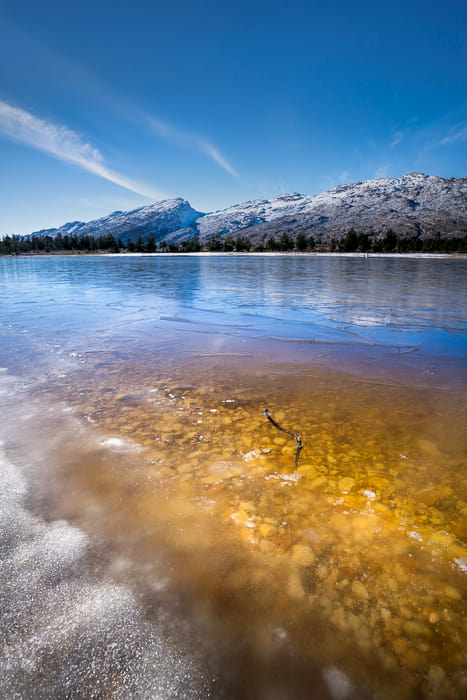
Frozen dam with the Matroosberg mountain range in the background. Shot at 17mm 1/40th second at f8 with ISO 50. Photo Jay Caboz
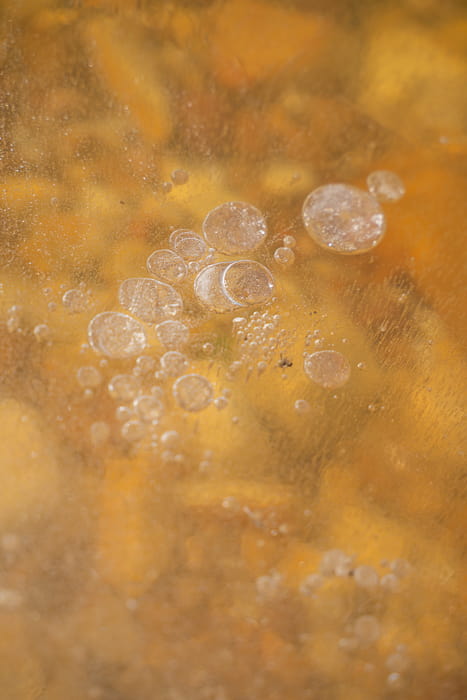
The water was completely see through and froze sticks and even air pockets. Photo Jay Caboz
After checking out we then decided to try re-visiting the 4 x 4 track in the hopes that it had opened – which it hadn’t. So we chucked on our waterproof hiking boots and then headed up the trail by foot.

After a steep 20-minute slog we found some good vantage points from just above Landy Corner. Photo Jay Caboz
After a steep 20-minute slog we found some good vantage points from just above Landy Corner. It was worth the sweat out especially when the sun tipped over the ridgeline and warmed the valley up. We had a great time building snowmen and having snowball fights.
While we may have missed the opportunity to get good sunrise shots it was an experience I would do again in a heartbeat. It’s a harsh lesson to be reminded of but Landscape photography is all about luck and being in the right place at the right time.
Here are some more tips to get the most out of your shoots:
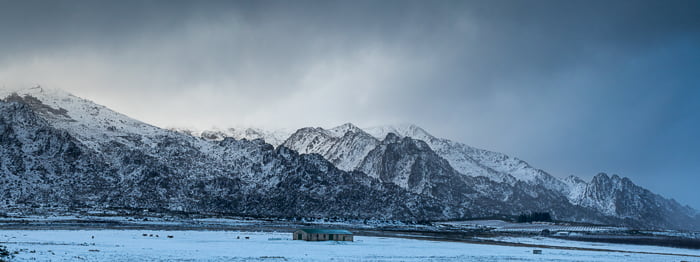
Snowstorm on the R303 near the Ceres Valley (2018). Photo Jay Caboz
Come prepared for warmth.
Shooting in snow can be quite challenging and it’s important to come prepared. First and foremost: bring the correct clothes, gloves, and the correct shoes. Staying warm is essential and you can’t underestimate how cold it can get once you move into the shade or a higher altitude.
It’s also a good idea to bring along a towel. Wind easily shifts snow around and you will need to continuously check your lens for droplets. If you are changing lenses do so in a bag to limit dust sitting on your sensor.

Sunrise at the top of Perdekop mountain trail, Mont Rochelle, Franschhoek. Shot at 17mm 1/160 second at f6.3 ISO 200. Photo Jay Caboz
Try to get up early for sunrise or stick around for sunset and look for pops of colour
Snow is incredibly beautiful at sunrise and sunset. I’ve found the snow can be especially beautiful during Blue Hour when it reflects the warm glow of the sky. If you are planning a hike, try arranging to get to a viewpoint at least an hour before and watch as the lights shifts can changes across the snow as it gets closer to sunrise. A flask of steaming hot coffee or hot chocolate courtesy of some freshly melted snow will make it a sunrise to remember.
If you are unsure of where the sun will be, I use an app called Photopills to tell me exactly where the sun will break the horizon and at what times. It’s a super handy tool for planning your trips.
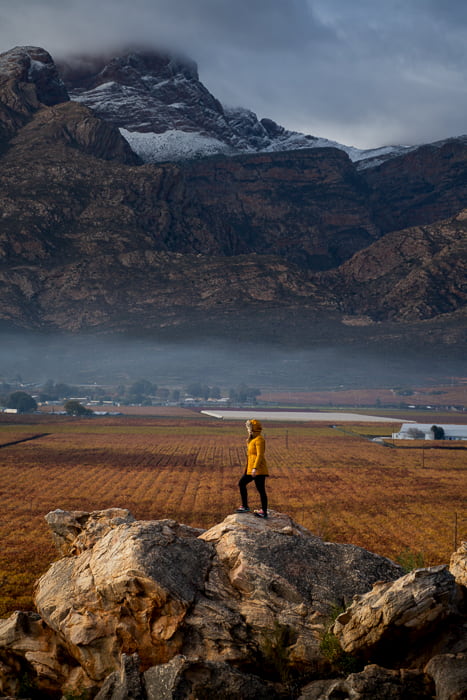
Looking for inspiration? Try looking for pops of colour. Hex River Valley shot at 75mm 1/160 second at f3.5 ISO 100. Photo Jay Caboz
Versatile gear is best
A long-range telephoto lens – like a 70-200mm – as well as a wider 17-28mm are great assets to have on a mountain. The first is great for shooting mountain peaks, and the second for bringing out subjects in the foreground.
Main Image: The Matroosberg valley, just above Landy Corner on the 4 x 4 trail. Shot at 20mm with 1/800th second at f9 and ISO 100. Image Caryn Caboz
Shop for a cause
Shop on amazon.com | amazon.co.uk
